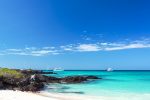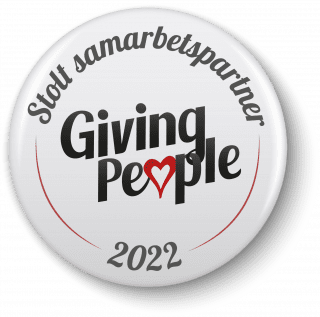A visit to the fascinating upper world of the Galapagos. Here you experience spectacular wildlife both above and below the water surface. The diversity of fish, birds, mammals and reptiles distinguishes the Galapagos from other marine areas – here we are guests on the conditions of nature and animals. Here you share the water with penguins, sea lions, sea iguanas, sea turtles, sperm whales, humpback whales and hammerhead sharks. Enjoy amazing days and starry nights at sea!
Contact form

Ecorating: 3.5
This product meets our requirements for Ecorating, a product that is good for humans and the environment.
Does my trip make a difference?
Read more
This product meets our requirements for Ecorating, a product that is good for humans and the environment.
Sample Itinerary
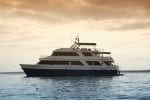
You arrive at the ship, which is waiting for us at the port of Puerto Baquetizo Moreno on the island of San Christobal. Check in, get a brief overview of the ship and safety on board followed by lunch. Then we leave for Playa Ochoa, where we stay for the night. Time to snorkel or dive in this beautiful place, where i.a. a colony of sea lions lives. See if you can spot a Chathamalbatros, an extremely rare bird that has been seen in the area several times. At sunset we sail close to the famous Kicker Rock – a cliff that rises in the middle of the sea and is inhabited by the most beautiful frigate birds of various kinds. In the evening, the guides give a slightly longer introduction to the Galapagos Islands, and the captain welcomes everyone with a cocktail.
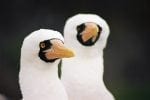
We spend all day on the island of Tower, one of the most unique islands in the Galapagos. We go ashore for a walk through lava fields, here we can see large colonies of swallows and other exciting birds – if we are lucky, we also see the short-eared barn owl. After the walk, a trip along the beach and coast in a canoe awaits, a perfect way to get close to birds and nature. Enjoy a good lunch on board, grab a siesta or relax with a book or podcast in a sun lounger. The afternoon offers, among other things, a visit to a cactus and mangrove forest, to swim or snorkel, before we continue west during the evening. Dinner on the ship and overnight.
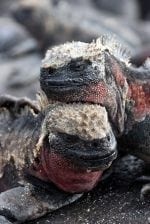
Today we spend the morning on Fernandina, one of the most exciting islands here in the Galapagos. Sea iguanas and sea lions are the ones who decide here. An adventurously beautiful island. After lunch we sail via the Bolivar Canal between the islands of Fernandina and Isabela, the area is known for the many dolphins and whales. We continue on to the western part of the island of Isabell, explore a saltwater lagoon and perhaps end the day with a snorkeling trip before there is time for dinner under the starry sky.
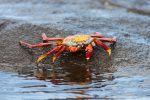
Today the trip goes to the area of Puerto Egas on the island of Santiago. Hike along the coast – look for squid and starfish. Here you can also often see, among other things, night herons and galapagos herons. Instead of snorkeling, you can borrow a canoe to quietly glide along the shore. During lunch we continue by motor to Sombrero Chino – the place is located all the way to the south on Santiago Island. We drop anchor in a quiet area and have dinner.
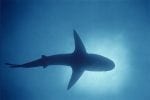
On the island of Bartolome, it feels like we are walking on the moon. No plants or animals thrive here. We climb a volcano. Crystal clear water lures with amazing snorkeling among Galapagos penguins, sea turtles and white sharks.
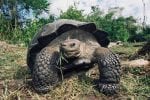
Today we travel by bus from Santa Cruz. The landscape gradually changes as we slowly pass through the seven different types of vegetation found here. We visit the turtle reserve on a private farm where we see giant turtles. We visit large volcanic craters where we can see the beautiful Vermillion flycatchers. Lunch on the ship and we take the opportunity to visit Charles Darwin Research Station. Here you will find scientists and nature lovers from all over the world. This is also an opportunity to stroll around the largest city on the Galapagos Islands – Puerto Ayora. Buy some souvenirs, get some postcards sent or relax with a cup of coffee. Dinner is served on board, but it is also possible to spend the evening in Puerto Ayora.

Today we visit Isla Espanola, a beautiful island where we can experience a fantastic diversity – here lives the largest concentration of species unique to the Galapagos Islands. This is what many people imagine the Galapagos Islands are: sea lions curiously welcome us when we go ashore, in the air fly elegant Galapagos albatrosses, which from April to November perform wild mating rituals, here are gannets, gulls, red-billed tropical birds, finches in beautiful colors, Galapagos buzzards and much more to look at and be impressed by. On our last day on the islands, we now take a hike on Espanola’s white sandy beaches followed by a fantastic canoe trip up to Tortura Rock. The afternoon is spent with the captain and our guides for one last good talk about the week’s experiences and a cocktail.
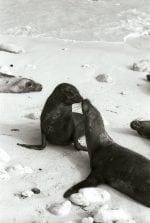
We stop in Puerto Baquerizo up San Christobal and visit the Interpretation Center – here we get a deeper understanding of the history of man, nature and wildlife in this spectacular part of the world. Transfer to the airport for further transport to the mainland. Homecoming or maybe even more adventures await?
Trip details
Ecorating: 3.5
Hotel standard: 4
When can you travel?All year
Airport: Quito Mariscal Sucre (UIO).
Travel length: 7 nights
Ecohotel: M / S Eric, Letty & Flamingo
The price includes: Return flight to Quito and domestic flights to the Galapagos Islands, entrance fees to various nature parks and areas, transit card, part of double cabin, full board, water, soda and snacks, welcome and farewell cocktail, all excursions as described in the program, equipment such as wetsuits, snorkeling gear, canoe equipment, guide service, transfer round trip from the airport in San Christobal.
Price does not include: Alcoholic beverages on board, gratuity, local airport taxes.
Good to know about the Galapagos and Ecuador:
Travel Ethics: You’re visiting one of the most unique places on the planet. It is strictly forbidden to throw with waste, affect or destroy flora and fanua. Nothing should be taken to the Galapagos Islands that could affect ecosystems, nor should anything leave the islands. Feel free to bring small banknotes in USD to tip.
Visa: Danish citizens do not need a visa to travel to Ecuador and the Galapagos Islands. However, the passport must have a minimum of two blank pages, and be valid for a minimum of six months after returning home.
Time zone: GMT -5
Vaccination: Read more about which vaccinations you haveneed here
Packaging: Sunglasses, sun hat, sunscreen, snorkel-friendly swimwear and good hiking shoes / hiking boots.
Local Currency: USD
Weather: San Cristóbal
Mobile and Internet coverage: Good coverage. Wifi in the hotel.
Water: Buy bottled water, make sure the bottles do not end up in nature. The water quality in the taps varies.
Safety: The Galapagos Islands are a safe place for tourists. But be aware that the roads in Ecuador (on the mainland) are affected by accidents and are of poor quality. As in all major cities in the world, there is a risk of pickpocketing or the like in the big city of Guayaquil.

Ecorating: 3.5
This product meets our requirements for Ecorating, a product that is good for humans and the environment.
Does my trip make a difference?
Read more
This product meets our requirements for Ecorating, a product that is good for humans and the environment.
Ecoventura – our partner in the Galapagos Islands
Your trip helps support Ecoventura, which we have selected to help us with our travels to this unique environment and unique nature. You run your business responsibly and inspire others to follow. The boat company works actively according to many of the principles of sustainable tourism. One works e.g. with not having more than 10 guests per. guide, this to reduce the environmental impact and minimize the stress that a larger herd could expose the animals to.
It helps to monitor and enforce park regulations, uses water efficiently and handles waste responsibly.
It has had a Smart Voyager environmental certification since 2000.
The company supports local conservation projects in the sea and supports and employs locals in tourist activities, reducing the local population’s dependence on fishing. Scholarships are given to children in the area to give them the opportunity to learn more about nature and ecosystems.
Guests are offered to participate in the form of donations, reduce oil consumption by installing high-efficiency filters and work to become CO2-neutral – this applies to both the ships but also the company’s offices.
In 2006, the Galapagos Marine Biodiversity Fund was launched in collaboration with the Word Wildlife Fund (WWWF).
Awards and Certifications
Smart Voyager Certification 2000 (Rain Forest Alliance)
